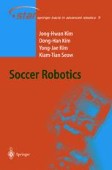Search
Search Results
-
Attacks and Cascades in Complex Networks
This paper reviews two problems in the security of complex networks: cascades of overload failures on nodes and range-based attacks on links....
-
Tomography and Stability of Complex Networks
We study the structure of generalized random graphs with a given degree distribution P(k), and review studies on their behavior under both random...
-
Topology, Hierarchy, and Correlations in Internet Graphs
We present a statistical analysis of different metrics characterizing the topological properties of Internet maps, collected at two different...
-
The Small World Phenomenonin Hybrid Power Law Graphs
The small world phenomenon, that consistently occurs in numerous existing networks, refers to two similar but different properties — small average...
-
4. How to Decide and Act? Use Intelligent Systems and Control Techniques
In robot soccer, the game situation in the playground is typically read in terms of the robots’ postures and the ball’s position. Using real-time...
-
On The Problem of Simultaneous Localization, Map Building, and Servoing of Autonomous Vehicles
In this chapter, we consider three of the main problems that arise in the navigation of autonomous vehicles in partially or totally unknown...
-
Model-Based Friction Compensation
Compensation of nonlinear friction terms is a most challenging application of high resolution encoders, which are nowadays getting available for...
-
Fuzzy-Neural Impedance Control for Robots
In conventional impedance control, the difficulties encountered in obtaining an exact system dynamic model and selecting its impedance parameters...
-
Coordination and Control of Multiarm Nonholonomic Mobile Manipulators
This chapter deals with the problem of suitably coordinating the manoeuvring of a nonholonomic vehicle and the motin of a supported manipulation...
-
Adaptive Robust Fuzzy Tracking Control for a Class of Nonlinear Systems
The tracking control problem for a class of nonlinear systems with uncertain system function and uncertain gain function, which are the unstructured...
-
Measuring and Improving Performance in Anti-Windup Laws for Robot Manipulators
In this chapter we provide a high performance solution to the anti-windup problem for control systems of robot manipulators undergoing actuator...
-
Robust Stability of Interval Lur’e Systems: A Bilinear Matrix Inequality Approach
This paper provides a sufficient condition for an interval Lur’e system to be globally exponentially stable with a dam** factor. The Lur’e system...
-
3-D Grasp Analysis and Synthesis Using the Ray-Shooting Technique
The ray-shooting technique is a powerful tool for handling geometric information in Computational Geometry and Computer Graphics. This chapter...
-
Intelligent Technologies for Robotic Welding
This paper discusses intelligent technologies for the robotic welding, which contains computer vision sensing, automatic programming for weld path...
-
The Seam Tracking System for Submerged Arc Welding
The structure and the principle of seam tracking for submerged arc welding were introduced in this paper. The method of seam recognition with...
-
3 Prototy** and control of the nonholonomic manipulator
Since a nonholonomic manipulator was theoretically designed from the viewpoint of kinematic constraints and nonlinear control, mechanical...
-
Preliminary Probe of Embedded Real-Time Operating System and Its Application in Welding Control
This paper firstly introduces the concept of real-time and embedded system, then analyses the character of welding and the advantages of adopting...
-
Critical Phenomena in a Small World
We consider the behavior of various systems on a small-world network near a critical point. Our starting point is a different, nonrandom system with...
-
Who Is the Best Connected Scientist?A Study of Scientific Coauthorship Networks
Using data from computer databases of scientific papers in physics, biomedical research, and computer science, we have constructed networks of...
-
Scholarly Information Network
I review the background and some recent trends of a particular scholarly information network, ar**v.org, and discuss some of its implications for new...
